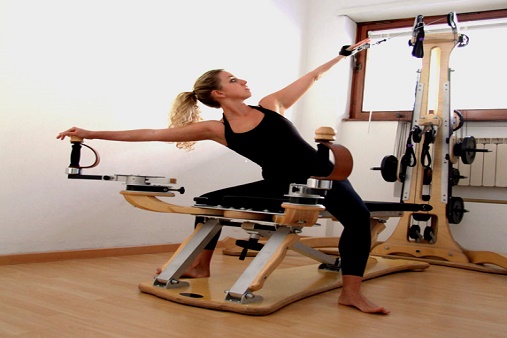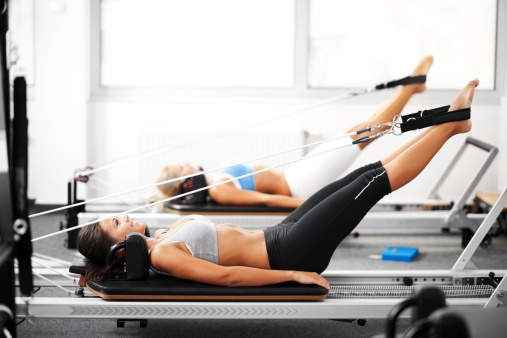There are several types of workouts that can make the body healthy and fit. Of the many exercise systems, two of the most popular forms are the Gyrotonic and Pilates. Designed to boost health and physique, Gyrotonic and Pilates are similar and amazing systems consisting of both equipment and non-equipment based exercises for building strength and flexibility. In fact, just as Joseph Pilates was inspired by his own childhood asthma and rickets to develop Pilates, the Romanian-born dancer Julius Horvath created the Gyrotonic expansion system to help with the rehabilitation of his back and Achilles tendon injuries. Besides, both Pilates and Gyrotonic are a culmination of other innovations in movement, exercise philosophies and healing arts. For instance, the development of Pilates was influenced by reflexology during footwork and usage of movement to control internal organs while the development of Gyrotonic draws from acupuncture meridians and Qigong.
In summary, both systems:
- Increase balance, coordination and flexibility
- Focus on core strength and moving the center
- Can be vigorous or gentle, athletic or rehab
- Can be either equipment based or non-equipment based
- Involve coordination of breath with movement
- Have private classes and group classes
- Use system specific equipment
- Maintain or boost spinal integrity
- Are adaptable to all types of bodies and all levels of experience
Nevertheless, while the two systems have many similarities, they are distinguished by their different approaches and techniques. In fact, from a dance perspective, Gyrotonic is usually likened to a modern dance while Pilates is likened to ballet. So, what is the difference between Pilates and the Gyrotonic?

(a) Different Dimensions
Pilates is primarily a two-dimensional linear technique whose exercises include extension, flexion, rotation and side-bending, with only one of these exercises performed at a time by beginners and two or more at a time by those in advanced levels. Basically, Pilates exercises focus on isolating muscle groups, opening joint space, lengthening while strengthening muscles, improving range of motion, sculpting and toning without adding bulk, and maintaining a stable and stationary neutral pelvis and spine, using specific breathing patterns. Pilates exercises are also used to awaken “sleepy” stabilizing muscles, particularly after injury or post-surgery. And as the student learns the more advanced levels, the exercises challenge the entire body in integrated movements and begin to flow like a dance.
On the contrary, Gyrotonic is a three-dimensional, circular technique whose exercises include extension, flexion, spiraling (rotation) and side-bending, but with two or more of the exercises performed at ago. Gyrotonic exercises move the whole body at all times (like a dance), ensuring a dynamically stable spine and pelvis, using specific breathing patterns.
(b) Primary Target
Pilates focus primarily on muscles, both small (intrinsic) and large (extrinsic) muscles, and aims at improving breath capacity. As a mind-body system designed to improve the overall range of motion, correct posture, boost pelvic and spinal stability, reduce stress and ease back, neck and shoulder pain, Pilates is invaluable in rehabilitative settings globally and has been used by professional dancers and athletes since the 1900s to boost performance and prevent injury. Pilates sessions may range from gentle and therapeutic exercises to advanced cross-training workouts for dancers and athletes.
On the other hand, Gyrotonic exercises not only focus on muscles, but also on the skeletal system, fascia and nervous system. Gyrotonic offers training in total mobility of the spine and joints while also focusing on the energetic aspects of body-mind-spirit connection (such as Tai Chi). Likewise, Gyrotonic is characterized by fluid and undulating movements (like swaying palms or waves), dynamic and playful sessions (with exercises such as dolphin, arch and curl, laughing Buddha, golden flower, frog, eagle, canoeing, spiraling, waves and snow shoes), and ability to either provide cardio enhancing sessions or gentle sessions. And because most movements performed in dance and sports can be incorporated in Gyrotonic equipment, professional athletes and dancers can benefit immensely from Gyrotonic cross-training.

(c) Equipment
Pilates relies primarily on spring-resistance equipment to challenge the body in varied ways and offer different ranges of motion. The most common pieces of Pilates equipment are Reformer, Chair, Cadillac and Barrels. The equipment utilizes spring resistance and allows users to work against spring tension during exercises in order to develop balanced strength, stability and flexibility. Pilates exercises performed with the equipment include feet in traps, footwork, long spine, the 100s, teaser, butterfly, swan dive, walk-over, mermaid, elephant, boxing and breaststroke.
Conversely, the main equipment in Gyrotonic is a weight and pulley system (the Pulley/Tower), which delivers both assistance and resistance to all movements while encouraging a decompression of the joints. Apart from the pulley/weight equipment, there are Gyrotonic specialized equipment such as the Ladder, Gyrotoner, Jump-Stretching Board and Leg Extension Unit, which are engineered to challenge and open the body in specific ways.
(d) Mind-Body Exercise
For most students of mind-body exercise, the muscle-isolating and linear nature of Pilates makes it amazingly easy to maintain good form and minimize the risk of injury. However, Gyrotonic is a completely different and unique world to students of mind-body exercise (Yoga, Tai Chi, Dance, Pilates) and many find it difficult to make the transition to Gyrotonic.
(e) Usage
While Pilates is invaluable in correcting specific muscular imbalances and postural problems, Gyrotonic is designed to mobilize the energy systems of the body and release any areas of restricted flow. Therefore, Gyrotonic is ideal in the treatment of chronic back pain, neck pain, spinal injuries, injuries from car accidents, shoulder impingement, scoliosis, fibromyalgia, repetitive stress injuries, and sports injuries.

